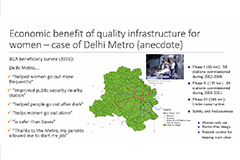Webinar Discusses Ways to Close the Gender Gap through Quality Infrastructure Development
2021.04.19
On March 26, 2021, the Organisation for Economic Co-operation and Development (OECD) Development Centre held a webinar entitled “DevTalks - Quality for equality? Making quality infrastructure work for gender equality.” Yamada Eiji, research fellow at the JICA Ogata Sadako Research Institute for Peace and Development (JICA Ogata Research Institute), spoke at this event about how quality transportation infrastructure promotes women's participation in economic activities. The webinar was held in the framework of the OECD initiative “OECD March on Gender” commemorating international women’s day, and moderated by Yuasa Ayumi, deputy director of OECD Development Centre.

Yamada Eiji, research fellow, spoke about how quality transportation infrastructure promotes women's participation in economic activities
Lack of access to quality infrastructure has deprived women and girls of education, employment, and many other opportunities. The event addressed questions such as how to accelerate gender mainstreaming and integrate gender considerations into infrastructure development as well as how to ensure women’s participation in decision-making processes. Three speakers shared their views on these questions.
Mary Chege, founding member of the African Union Commission’s African Network for Women in Infrastructure (ANWIN), gave the first presentation. She presented key statistics supporting the case for promoting gender equality on business and moral grounds. From the business perspective, she presented evidence demonstrating that as many as 60% of households in sub-Saharan Africa still lack on-site drinking water, forcing women to collectively spend an unpaid 16 million hours collecting water each day. If women spent this time participating in the economy as equals to men, they would contribute $28 trillion dollars to global GDP by 2025. From the moral perspective, she noted that building resilient infrastructure with 20- to 50-year operational life cycles without gender considerations will reinforce existing gender inequalities for decades to come. She also stated that each stage of an infrastructure project (enabling environment assessment, planning and design, tendering, construction, and operation and maintenance) must be well designed and implemented for the benefit of women.
Next, Yamada spoke about how quality infrastructure and gender mainstreaming in infrastructure projects can benefit women’s economic wellbeing, based on the results of the JICA Ogata Research Institute's research project "Study on the Methodology of Impact Analysis for Infrastructure Projects." Citing his own case study of the Delhi Metro, a project that the JICA has provided assistance for since 1990s, he showed that the metro increased the female labor-force participation in the vicinity of metro stations. He also stated that the findings of additional studies on other infrastructure projects that improved the employment opportunities and economic wellbeing of women, such as Bus Rapid Transit and the Lima Metro in Peru, support the quantitative evidence from the study of the Delhi Metro. He also discussed gender-responsive approaches, such as the introduction of quotas to increase the number of female construction workers in Ho Chi Minh City and the use of closed-circuit television surveillance in the Delhi Metro to prevent sexual violence. He noted, however, that very few rigorous studies has been carried out on gender-responsive infrastructure projects. He said that a major obstacle to producing better infrastructure policies informed by evidence is the lack of research, especially concerning gender-mainstreaming approaches in infrastructure projects. Indeed, he clearly pointed out the need for more rigorous evidence and more flexible project design in order to accommodate evaluation and experimentation.

Yamada shared his case study of the Delhi Metro (Photo:JICA/Kuno Shinichi)
Pierre Boissesons, an economist at the OECD Development Centre, gave the final presentation. He said that we need to understand that infrastructure is designed by men and for men's needs, and that historically, infrastructure design has been based on norms shaped by men. He blamed the lack of adequate sanitation facilities at schools in many developing countries as a significant barrier to education, preventing girls who are menstruating from attending school. He blamed this on the faulty design of school buildings. Therefore, improving basic infrastructure, such as sanitation facilities and water facilities, could have a profound impact on social life, spurring changes to traditional social norms that define the roles of men and women in the household. Also, he emphasized that for such change to occur, it is necessary to harness the digitalization of the economy, which he sees as a major opportunity for developing countries in coming years. He further stated that skill development will be central to ensuring that women benefit from Information and Communication Technology infrastructure. In addition, he argued that women are vastly under-represented in the STEM fields, and that any attempt to improve digital infrastructure and transform the economy must include substantial efforts to shift the fundamental norms that prevent women from joining the sector.
After the presentations, each speaker presented more specific ideas for improving gender equality. This was followed by a lively exchange of opinions.

事業事前評価表(地球規模課題対応国際科学技術協力(SATREPS)).国際協力機構 地球環境部 . 防災第一チーム. 1.案件名.国 名: フィリピン共和国.

事業事前評価表(地球規模課題対応国際科学技術協力(SATREPS)).国際協力機構 地球環境部 . 防災第一チーム. 1.案件名.国 名: フィリピン共和国.

事業事前評価表(地球規模課題対応国際科学技術協力(SATREPS)).国際協力機構 地球環境部 . 防災第一チーム. 1.案件名.国 名: フィリピン共和国.

事業事前評価表(地球規模課題対応国際科学技術協力(SATREPS)).国際協力機構 地球環境部 . 防災第一チーム. 1.案件名.国 名: フィリピン共和国.

事業事前評価表(地球規模課題対応国際科学技術協力(SATREPS)).国際協力機構 地球環境部 . 防災第一チーム. 1.案件名.国 名: フィリピン共和国.
scroll